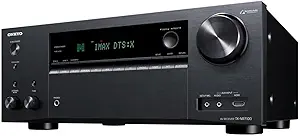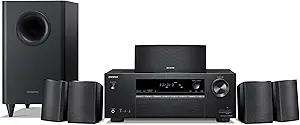Yamaha and Onkyo are two leading brands in the audio equipment industry, particularly known for their AV receivers. The Yamaha AV receivers are recognized for their state-of-the-art technology, such as the MusicCast Surround technology which allows for a wireless home theatre setup, and the YPAO (Yamaha Parametric room Acoustic Optimizer) which analyzes the room acoustics and adjusts the audio accordingly for the best sound quality. On the other hand, Onkyo AV receivers are applauded for their THX Certified Select system which guarantees the same high volume and low distortion levels experienced in commercial cinemas, and their Dynamic Audio Amplification that delivers a high-current sound control. In terms of connectivity, Yamaha AV receivers come with built-in Wi-Fi, Bluetooth, AirPlay, and Spotify Connect, allowing for a wide range of options for streaming music. Onkyo, on the other hand, also offers built-in Wi-Fi and Bluetooth, but they have Chromecast built-in and DTS Play-Fi, which Yamaha does not. However, some users have reported that Onkyo receivers tend to run hot, which may affect their longevity. Yamaha receivers, while they may lack some of the connectivity options of Onkyo, are generally reported to be more durable and reliable. Both brands offer a variety of models to cater to different user needs and budgets, and both are well-regarded for their sound quality and technological innovation.
Product Selection
Yamaha and Onkyo are two well-known brands in the audio equipment industry, both offering a wide range of AV receivers. Yamaha AV receivers are known for their advanced features and technologies such as MusicCast, a wireless multi-room audio system, and YPAO sound optimization for automatic speaker setup. They also offer a wide range of models, from entry-level to high-end, catering to various user needs and budgets. Yamaha's AV receivers are often praised for their sound quality and reliability, but some users have noted that their user interface can be complex and not as user-friendly as some competitors. On the other hand, Onkyo AV receivers are recognized for their THX-certified select sound and dynamic audio amplification, which delivers a cinema-like audio experience. They also feature proprietary technologies such as VLSC (Vector Linear Shaping Circuitry) for noise-free signal processing and AccuEQ room acoustic calibration for optimal sound. Onkyo provides a diverse product selection as well, from budget-friendly to premium models. However, while Onkyo receivers are generally well-received for their performance, there have been some concerns about their longevity compared to other brands. In terms of product selection, both Yamaha and Onkyo offer a wide range of options, but the choice between the two may come down to specific features, sound preferences, and budget considerations.
Availability
Yamaha and Onkyo are two prominent brands in the audio equipment industry, specifically in the AV receivers sector. The availability of their products varies significantly. Yamaha AV receivers are widely available across multiple platforms, both online and offline. They have a strong global presence, and their products can be found in many electronics stores and on various e-commerce websites such as Amazon, Best Buy, and their official Yamaha website. Yamaha's latest models, such as the RX-V6A and RX-V4A, which support 8K and 4K video respectively, are readily available for purchase. On the other hand, Onkyo AV receivers, while also available globally, may not be as widely distributed as Yamaha's. They are available on their official website and other online platforms like Amazon, but their presence in physical stores may be less extensive. However, Onkyo's latest models, such as the TX-NR696 and TX-NR595, which feature support for Dolby Atmos and DTS:X sound, are generally accessible. It's worth noting that the availability of both Yamaha and Onkyo AV receivers may be influenced by factors such as location and supply chain issues.
Design/Look
Yamaha and Onkyo AV receivers are two of the most popular brands in the audio equipment industry, each with their unique design features. Yamaha AV receivers are known for their sleek and minimalist design, often in a black or titanium finish, which fits seamlessly into any modern home theater setup. The latest models, such as the Yamaha RX-V6A, feature a clean front panel with touch-sensitive buttons and a large, easy-to-read display. The overall look is sophisticated and stylish, but some users have noted that the minimalist design can make the interface slightly less intuitive to use. On the other hand, Onkyo AV receivers, like the Onkyo TX-NR696, are known for their more traditional and robust design. They typically feature a larger number of physical buttons and knobs on the front panel, which some users find more user-friendly. The display is smaller than on Yamaha models, but it's clear and easy to read. Onkyo receivers are often larger and heavier than their Yamaha counterparts, which can be a disadvantage if space is limited, but they also give a solid and durable impression. The design of Onkyo receivers may not be as modern or sleek as Yamaha's, but they offer a classic look that many users appreciate.
Affordability
Most affordable brands
When it comes to the price aspect of Yamaha and Onkyo AV receivers, there are significant differences to consider. Yamaha AV receivers, renowned for their high-quality sound and latest technologies, such as MusicCast Surround and Dolby Atmos, tend to be more expensive. They offer a wide range of models, with prices starting from around $300 and going up to $3000 for their top-end models like the Yamaha Aventage RX-A3080. This high price range is often justified by the brand's reputation for durability, excellent customer support, and the inclusion of cutting-edge features. On the other hand, Onkyo AV receivers are generally more affordable, making them a popular choice for those on a tighter budget. Despite their lower price, Onkyo receivers still offer impressive features, including Dolby Atmos, DTS:X, and their proprietary AccuEQ room calibration technology. Prices for Onkyo receivers typically range from around $200 to $1000, like the Onkyo TX-NR696. However, some users have reported reliability issues with certain Onkyo models, which may be a trade-off for the lower price. Compared to other brands in the market, both Yamaha and Onkyo offer competitive pricing, with Yamaha catering more to the high-end market and Onkyo focusing on providing value for money.
Quality/Durability
Yamaha and Onkyo are two of the most reputable brands when it comes to AV receivers, both offering a range of products known for their quality and durability. Yamaha AV receivers are recognized for their robust build and longevity. They incorporate the latest technologies such as Dolby Atmos and DTS:X for immersive sound, and MusicCast for multi-room audio. Yamaha's reputation for quality is backed by their use of high-grade components, such as Burr-Brown DACs in their higher-end models, which ensures excellent sound reproduction and durability. However, some users have reported that Yamaha's user interface can be a bit complex and not as user-friendly as some other brands. On the other hand, Onkyo AV receivers are also known for their durability and high-quality sound. They feature technologies like THX certification, which guarantees cinema-level sound quality, and Chromecast built-in for easy streaming. Onkyo's use of VLSC (Vector Linear Shaping Circuitry) technology for noise-free signal path is a testament to their commitment to quality. However, some users have reported issues with HDMI board failures in some older models, which can affect the receiver's longevity. Despite this, Onkyo has been proactive in addressing these issues in their newer models. Comparatively, both brands offer excellent quality and durability, but user experience may vary based on individual preferences and specific model features.
Reputation
Yamaha and Onkyo are both reputable brands when it comes to audio equipment, specifically AV receivers. Yamaha, a Japanese brand, has been in the audio equipment industry for over a century and is known for its high-quality sound and durable products. Their AV receivers, such as the latest AVENTAGE series, are praised for their advanced technology like Surround:AI that automatically adjusts the sound in real-time, and MusicCast which allows for multi-room audio setups. However, some users have noted that Yamaha's user interface can be a bit complex for beginners. On the other hand, Onkyo, another Japanese brand, has also been a long-standing player in the audio equipment industry. They are known for their precision in sound quality and innovative features. Their latest TX-NR series of AV receivers feature Dolby Atmos and DTS:X technologies for immersive sound experiences. Onkyo receivers are also equipped with the latest HDMI standards, supporting 4K and HDR pass-through. However, some users have reported issues with Onkyo's customer service and product reliability over time. In comparison to other brands, both Yamaha and Onkyo hold their ground in terms of technological advancements and sound quality. However, Yamaha's reputation for durability seems to edge out Onkyo's reputation for innovation.
Conclusion
Yamaha and Onkyo are both reputable brands in the audio equipment industry, particularly in the field of AV receivers. Yamaha AV receivers are known for their advanced technologies such as MusicCast, which allows for multi-room audio setups, and YPAO sound optimization, which calibrates the receiver to the room's acoustics for optimal performance. On the other hand, Onkyo AV receivers are lauded for their THX certification, ensuring cinema-level sound quality, and their Dynamic Audio Amplification technology, which delivers a high instantaneous current to the speakers for precise control and enhanced audio clarity. In comparison to other brands, Yamaha and Onkyo both offer high-quality audio performance. However, Yamaha tends to focus more on the musicality of their receivers, making them a popular choice for music lovers. Onkyo, on the other hand, is often praised for its home cinema capabilities. The choice between the two would largely depend on the specific needs and preferences of the user. For instance, a user seeking an immersive movie-watching experience might lean towards Onkyo, while a music enthusiast might prefer Yamaha. Both brands have their strengths and weaknesses, and the choice ultimately depends on the user's individual requirements and preferences.




















